Related Research Articles

Highland Avenue is an active commuter railroad station in Orange, New Jersey. One of two in the city, along with the eponymous Orange station, Highland Avenue is serviced by trains of New Jersey Transit's Morris and Essex Lines: the Morristown Line and Gladstone Branch. Trains through the station run between New York Penn Station and Hoboken Terminal to the east and Hackettstown and Gladstone. The station contains two low-level side platforms for the three tracks that run through the station.

Mountain Station is a New Jersey Transit station in South Orange, Essex County, New Jersey, United States, along the Morris and Essex. The station, built in 1915, was designed by Frank J. Nies. It has been listed in the New Jersey Register of Historic Places and National Register of Historic Places since 1984 and is part of the Operating Passenger Railroad Stations Thematic Resource.

Mount Olive is a NJ Transit station in Mount Olive, New Jersey, located in the International Trade Center. The station, located on the side of Waterloo Valley Road, services trains for both the Montclair-Boonton Line and the Morristown Line along trackage owned by Norfolk Southern. The line is not electrified from Hackettstown to Dover, where passengers can transfer to an electric Morristown Line train via Summit or a diesel Montclair-Boonton train via Wayne and Montclair. Trains along both lines head to Hoboken Terminal in Hoboken, New Jersey or New York Penn Station at 34th Street in New York City, although Montclair-Boonton trains require a transfer at Montclair State University or Newark Broad Street for electrified service to New York. It is also the least-used station in the NJ Transit commuter rail network.
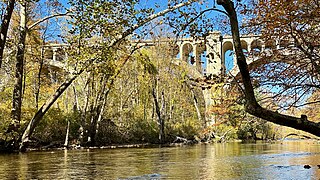
The Paulinskill Viaduct, also known as the Hainesburg Viaduct, is a reinforced concrete railroad bridge that crosses the Paulins Kill in Knowlton Township, New Jersey. When completed in 1910, it was the largest reinforced concrete structure in the world.
William Haynes Truesdale (1851–1935) was an American railroad executive. He served as the president of the Delaware, Lackawanna and Western Railroad (DL&W) from 1899 to 1925.
The Boonton Branch refers to the railroad line in New Jersey that was completed in 1870 and ran 34 miles (54.8 km) from Hoboken to East Dover Junction as part of the Morris & Essex Railroad (M&E). Although the branch hosted commuter trains, the line was primarily built as a freight bypass line. The term "branch", therefore, is somewhat of a misnomer since the Boonton Branch was built to higher mainline standards than the Morristown Line, the line that it bypassed. As a result, the Boonton Branch better meets the definition of a "cut-off" rather than a branch. Some of the towns that the Boonton Branch passed through included Lyndhurst, Passaic, Clifton, Paterson, Wayne, Lincoln Park, Mountain Lakes, and its namesake, Boonton.

Port Morris Junction is the railroad connection between NJ Transit's Montclair-Boonton Line and the Lackawanna Cut-Off. Opened in 1911 by the Lackawanna Railroad, it is in the Port Morris, New Jersey section of Roxbury Township, New Jersey, south of Lake Hopatcong.

Waltz & Reece Cut is the deepest cut on the Lackawanna Cut-Off railroad line in northwest New Jersey. The cut is 0.68 miles (1.09 km) long, has an average depth of 37 feet (11 m), and a maximum depth of 114 feet (35 m).
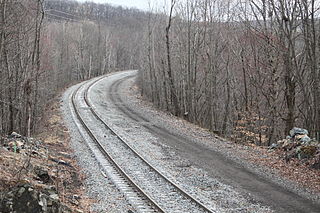
Bradbury Fill is one of the embankments on the Lackawanna Cut-Off railroad line in northwest New Jersey. It was built from 1908 to 1911 by Waltz & Reece Construction Company. It sits between mileposts 49.1 and 49.8 in Byram Township, just west of Waltz & Reece Cut and east of Lubber Run Fill.

Lubber Run Fill is a fill on the Lackawanna Cut-Off railroad line in northwest New Jersey. Located between mileposts 50.1 and 50.5 in Byram Township, it was built between 1908 and 1911 by contractor Waltz & Reece Construction Company. It is 0.40 miles (0.64 km) long, has an average height of 64 feet, and a maximum height of 98 feet. Most of its 720,000 cubic yards (550500 m3) of fill material was excavated from the surrounding low-lying area.

Colby Cut is one of a number of cuts on the Lackawanna Cut-Off railroad line in northwest New Jersey. Located between approximately mileposts 51.8 and 52.3 in Byram Township, the cut was constructed between 1908 and 1911 by contractor David W. Flickwir. The cut, which was created by removing fill material obtained by blasting with dynamite or other methods, is 0.53 miles (0.85 km) long, has an average depth of 45 feet (14 m), and a maximum depth of 110 feet (34 m). The cut was the result of the removal of 462,342 cubic yards of fill material within this section.

Ramsey Fill is one of the fills (embankments) on the Lackawanna Cut-Off railroad line in northwest New Jersey. Located between miles 60.4 and 60.9 in Frelinghuysen Township, the fill was constructed between 1908 and 1911 by contractor Hyde, McFarlan & Burke. The .53-mile (0.85 km) fill has an average height of 21 feet, and a maximum height of 80 feet. It was created with 805,481 cubic yards (615,834 m3) of fill material obtained by blasting with dynamite or other methods.
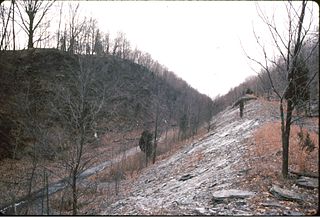
Armstrong Cut is one of the largest cuts on the Lackawanna Cut-Off railroad line in northwest New Jersey. Located between approximately mileposts 61.4 and 62.3 in Frelinghuysen Township, the cut was constructed between 1908 and 1911 by contractor Hyde, McFarlan & Burke. The cut, which was created by removing fill material obtained by blasting with dynamite or other methods, is 0.89 miles (1.43 km) long, has an average depth of 52 feet (16 m), and a maximum depth of 104 feet (32 m). The fill was created as a result of the removal of 852,000 cubic yards of fill material from this section of the right-of-way. Armstrong Cut is located on a tangent (straight) section of track, permitting 80 mph (130 km/h).
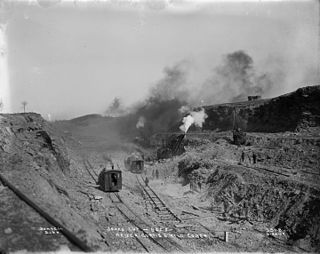
Jones Cut is one of the cuts on the Lackawanna Cut-Off railroad line in northwest New Jersey.

Vail fill is one of the fills on the Lackawanna Cut-Off railroad line in northwest New Jersey. Located between approximately mileposts 65 and 65.3 in Blairstown Township, the fill was constructed between 1908 and 1911 by contractor Hyde, McFarlan & Burke. The fill, which was created by fill material obtained by blasting with dynamite or other methods, much of which was obtained from nearby Jones Cut, the fill is 0.32 miles (0.51 km) long, an average of 39 feet (12 m) high, and a maximum of 102 feet (31 m) tall. The fill contains a total of 293,500 cubic yards of material. Vail Fill is located on a 1° curved section of track, permitting 80 mph (130 km/h).

The Nicholson Cutoff is a rail line segment of the Sunbury Line rail line and formerly a rail line segment of the Delaware, Lackawanna and Western Railroad main line and the Delaware and Hudson Railway South Line. The Nicholson Cutoff and the rest of the Sunbury Line is owned by Norfolk Southern Railway.
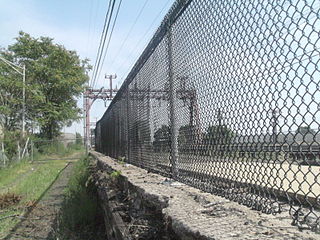
Harrison was a station on New Jersey Transit's Morris & Essex Lines in Harrison, New Jersey, United States. The station was built by the Delaware, Lackawanna and Western Railroad in 1906. It was situated between Newark Broad Street Station and Hoboken Terminal.
The Waltz & Reece Construction Company was a construction company that operated in the first quarter of the 20th century, best known for its work on the Lackawanna Cut-off in New Jersey.
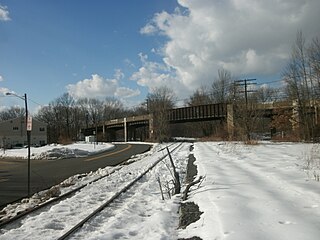
Mountain View was a station on the Boonton Branch of the Delaware, Lackawanna and Western Railroad. Located in the Mountain View section of Wayne Township, New Jersey, the station was at the Parish Drive bridge over the tracks. The station was 20.8 miles (33.5 km) away from its terminus at Hoboken Terminal on the shores of the Hudson River, where connections would be made to New York City via ferry and the Hudson and Manhattan Railroad. The western terminus. Denville, was 12.8 miles (20.6 km) away, where connections with the Morris and Essex Railroad were available. Just west of the station was Mountain View junction, where a connection was made to the Erie Railroad's New York and Greenwood Lake Railway was made.

The Hampton Branch was a railway line in the state of New Jersey. It ran 5.2 miles (8.4 km) from Hampton, New Jersey, to Washington, New Jersey, connecting the main line of the Central Railroad of New Jersey with the old main line of the Delaware, Lackawanna and Western Railroad (Lackawanna). It was built by the Warren Railroad in 1853–1856 and abandoned by the Lackawanna in 1958.
References
- ↑ Sweeney, Alan & Judy Sweeney (2005). Gateway to the Clouds: The Story of a Short Line Railroad, The Scranton, Dunmore, Moosic Lake Railroad, 1902-1926. Tribute Books. ISBN 9780976507222
- ↑ Taber, Thomas Townsend; Taber, Thomas Townsend III (1980). The Delaware, Lackawanna & Western Railroad in the Twentieth Century 1, pp. 65-100. Muncy, PA: Privately printed. ISBN 0-9603398-2-5.
- ↑ Moodys Manual of Railroads and Corporation Securities. Moody Manual Company. 1922. pp. 650–651.
- ↑ Sweeney, Alan & Judy Sweeney (2005). Gateway to the Clouds: The Story of a Short Line Railroad, The Scranton, Dunmore, Moosic Lake Railroad, 1902-1926. Tribute Books. ISBN 9780976507222
- ↑ Sweeney, Alan & Judy Sweeney (2005). Gateway to the Clouds: The Story of a Short Line Railroad, The Scranton, Dunmore, Moosic Lake Railroad, 1902-1926. Tribute Books. ISBN 9780976507222.
- ↑ Taber, Thomas Townsend; Taber, Thomas Townsend III (1980). The Delaware, Lackawanna & Western Railroad in the Twentieth Century 1, pp. 35-41. Muncy, PA: Privately printed. ISBN 0-9603398-2-5.
- ↑ Taber, Thomas Townsend; Taber, Thomas Townsend III (1980). The Delaware, Lackawanna & Western Railroad in the Twentieth Century 1, pp. 35-41. Muncy, PA: Privately printed. ISBN 0-9603398-2-5.
- ↑ "Burke Brothers to Dissolve". Steam Shovel and Dredge. 12: 505. January 1908.